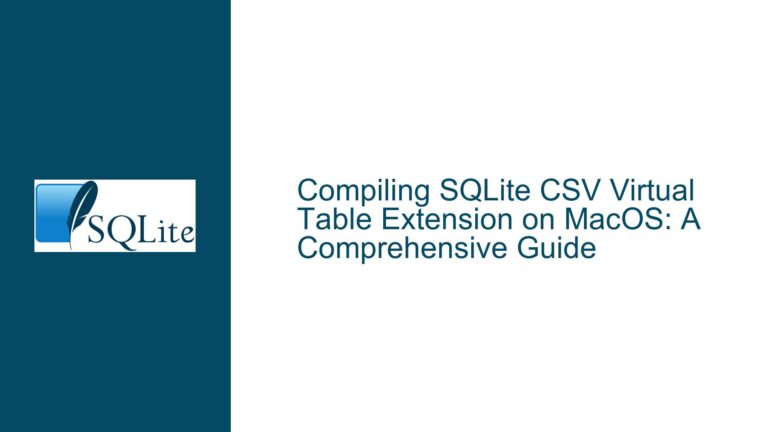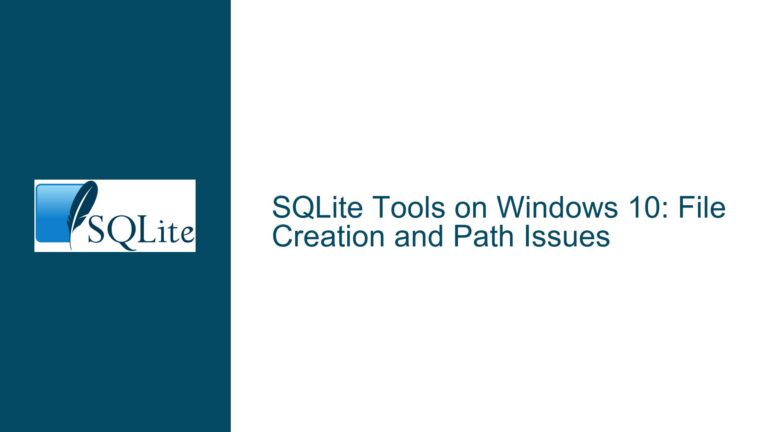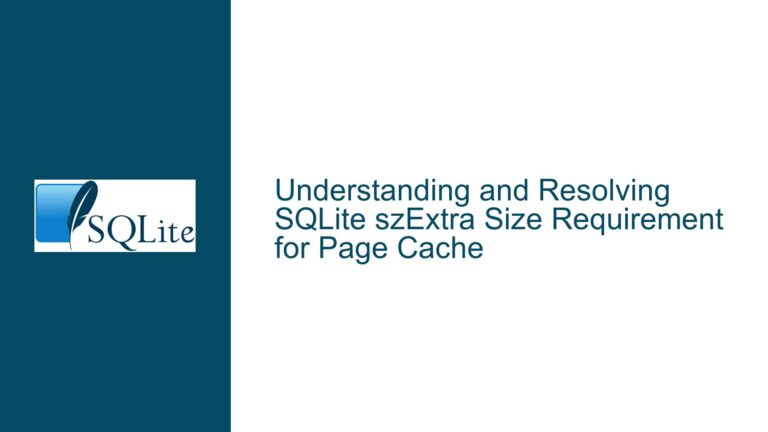NPE Bug in SQLite-JDBC Update Operation with Null First Parameter
Issue Overview: Null Pointer Exception in SQLite-JDBC Update Operation
The core issue revolves around a Null Pointer Exception (NPE) that occurs during an update operation in the SQLite-JDBC library, specifically when the first parameter in the update query is set to null. This issue manifests exclusively in versions 3.41.2.2 and 3.42.0.0 of the org.xerial:sqlite-jdbc library. The problem does not occur if the null value is assigned to any parameter other than the first one. The stack trace indicates that the NPE originates from the CoreStatement.checkIndex method, which is part of the SQLite-JDBC library, and propagates through the Spring JDBC framework.
The update query in question follows this structure:
UPDATE TABLE_NAME SET revision=revision + 1, column2 = ?, column3 = ?, ... WHERE id = ?
When the first parameter (column2) is null, the operation fails with an NPE. This behavior was not observed in earlier versions of the library, such as 3.32.3.2, where the same query executed successfully even with a null first parameter.
The issue is significant because it disrupts the normal flow of database operations in applications that rely on the SQLite-JDBC library, particularly those using the Spring JDBC framework for database interactions. The problem is exacerbated by the fact that it only occurs under specific conditions, making it harder to diagnose and resolve.
Possible Causes: Misalignment Between SQLite-JDBC and Spring JDBC Parameter Handling
The root cause of the NPE appears to lie in the interaction between the SQLite-JDBC library and the Spring JDBC framework, specifically in how parameters are handled during the preparation and execution of update statements. The following factors contribute to the issue:
Parameter Index Validation in SQLite-JDBC: The
CoreStatement.checkIndexmethod in the SQLite-JDBC library is responsible for validating parameter indices before setting their values. When the first parameter isnull, this method throws an NPE, suggesting that the validation logic does not account fornullvalues at the first index.Type Inference in Spring JDBC: The Spring JDBC framework uses the
StatementCreatorUtils.setNullmethod to setnullvalues in prepared statements. This method relies on thegetParameterTypemethod of the underlying JDBC driver to determine the SQL type of the parameter. If the SQLite-JDBC library fails to handlenullvalues correctly at the first index, the type inference process may break, leading to the NPE.Version-Specific Behavior: The issue is absent in earlier versions of the SQLite-JDBC library (e.g., 3.32.3.2), indicating that changes introduced in versions 3.41.2.2 and 3.42.0.0 altered the parameter handling logic. These changes may have inadvertently introduced a regression that affects the handling of
nullvalues at the first parameter index.Library Version Mismatch: The version numbers reported in the issue (e.g., 3.41.2.2, 3.42.0.0) do not align with the official SQLite versioning scheme, which uses three-number versions (e.g., 3.42.0). This discrepancy suggests that the SQLite-JDBC library may have applied custom modifications or patches that are not present in the official SQLite release. These modifications could be the source of the regression.
Troubleshooting Steps, Solutions & Fixes: Diagnosing and Resolving the NPE in SQLite-JDBC
To address the NPE issue in the SQLite-JDBC library, follow these detailed troubleshooting steps and implement the recommended solutions:
Verify Library Versions and Dependencies:
- Confirm that the SQLite-JDBC library version being used is compatible with the application’s requirements. If possible, downgrade to a version where the issue does not occur (e.g., 3.32.3.2) as a temporary workaround.
- Check for any custom modifications or patches applied to the SQLite-JDBC library that may have introduced the regression. If the library is being built from source, review the commit history for changes related to parameter handling.
Isolate the Issue:
- Create a minimal reproducible example that demonstrates the issue. This example should include only the necessary components to trigger the NPE, such as a simple update query with a
nullfirst parameter. - Run the example with different versions of the SQLite-JDBC library to confirm that the issue is specific to versions 3.41.2.2 and 3.42.0.0.
- Create a minimal reproducible example that demonstrates the issue. This example should include only the necessary components to trigger the NPE, such as a simple update query with a
Debug the Parameter Handling Logic:
- Set breakpoints in the
CoreStatement.checkIndexandJDBC3PreparedStatement.getParameterTypemethods to observe the behavior when anullvalue is passed as the first parameter. - Examine the state of the
CoreStatementobject and its internal data structures to identify any inconsistencies or unexpected values that may be causing the NPE.
- Set breakpoints in the
Modify the Update Query:
- As a temporary workaround, rearrange the parameters in the update query so that the
nullvalue is not the first parameter. For example:UPDATE TABLE_NAME SET revision=revision + 1, column3 = ?, column2 = ?, ... WHERE id = ? - This change may prevent the NPE from occurring while a permanent fix is being developed.
- As a temporary workaround, rearrange the parameters in the update query so that the
Patch the SQLite-JDBC Library:
- If the issue is confirmed to be a bug in the SQLite-JDBC library, consider applying a patch to the
CoreStatement.checkIndexmethod to handlenullvalues correctly at the first parameter index. - Submit the patch to the maintainers of the SQLite-JDBC library for review and inclusion in future releases.
- If the issue is confirmed to be a bug in the SQLite-JDBC library, consider applying a patch to the
Update the Spring JDBC Configuration:
- Review the Spring JDBC configuration to ensure that it is compatible with the SQLite-JDBC library. Adjust any settings related to parameter handling or type inference if necessary.
- Consider using a different JDBC driver or database abstraction layer if the issue persists and cannot be resolved in a timely manner.
Monitor for Updates and Fixes:
- Keep an eye on the official SQLite-JDBC repository and issue tracker for updates related to the NPE issue. Apply any fixes or patches released by the maintainers as soon as they become available.
- Engage with the community by reporting the issue, sharing findings, and contributing to the development of a permanent solution.
By following these steps, you can diagnose the NPE issue in the SQLite-JDBC library, implement temporary workarounds, and contribute to the development of a permanent fix. This approach ensures that your application remains stable and functional while addressing the underlying problem.






